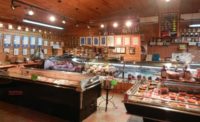Tales from Front Line: Eickman’s Processing

Tales from the Front Line is a series from Independent Processor magazine. In each article or video, a small processor discusses their business in the wake of the Coronavirus pandemic – what has changed, what has been successful, what the future holds.
This week, we feature Tom Eickman, owner of Eickman’s Processing Co. Inc. in Seward, Ill. Eickman’s has been family-owned and operated for 65 years and produces a variety of meat products and custom meat processing. Tom Eickman has worked at his family’s company since 1994, but this year marks the first year that he and his wife, Katie, officially took over as owners. His grandfather, Merlyn, launched the company in the 1950s, and his father, Tom, worked and later ran the business from 1964 until his retirement this year.
“At the start, we lost most of our catering jobs that were scheduled for the summer. When they closed up the restaurants in Illinois, we lost almost all of our wholesale accounts. At the same time though, our retail picked up tremendously. Customers were looking for ground beef, and we had it.
“We had slaughtered 12 cattle that were going to move to wholesale accounts in the cooler the week before, and I was worried what I was going to do with them. Then the retail picked up, and we easily moved all 12 cattle through the front cases. Ground beef was moving at 1,000 to 2,000 pounds per day. We were getting phone calls every two minutes wanting to know if we had ground beef. While others were running out of material to grind, we kept going.
“Most people were very good with it, only wanting 5 or 10 pounds. Since then, we have continued with a hectic retail area. At first it was great. It was like the busiest day leading up to Christmas times three, but then it didn’t end. It is starting to become something like “Groundhog Day.” Every day it starts again -- hitting the cases, trying to keep products in the cases, sanitizing the store, trying to find products to supplement what we can kill. After almost a month of this, it is wearing on everyone in the plant.

“On the other side of it, slaughter dates have gone completely insane. When this started, we were about three weeks out on cattle and two weeks out on hogs. We are currently booking December 9 for cattle and June 15 for hogs. Other plants in our area are at the same dates. With the uncertainty of what may come, we have cut back on some of our weekly numbers, but we are still at 30 cattle and 50 hogs a week.
“We have also seen the panic set in as they have reported the large plants closing. In the last week we have sold around 20 cattle in halves and quarters, and 20 hogs. We are telling customers it may be five or six weeks before we can get the animals in, aged and cut, and they are fine with it. On the plus side, the producers that have livestock are thrilled that I am buying and will have a home for some of their stock, but on the down side, they wish I could take more.
“I have had three phone calls in the last week from farmers wanting to sell loads of hogs because they have nowhere to go with them. I have also had some customers asking why the price isn’t bottom-of-the-barrel cheap, to which I reply that we believe in sustainability, and just because prices may be down, it doesn’t mean I will pay the bottom price. I watched as Grandpa and Dad both would give better prices to producers to ensure that they are sustainable. I continue that practice. In doing so, when I call on a producer to supply me with livestock, I know he will be there, and he is usually grateful. He will also help me out and make a special trip, or ensure I get only the best quality.
“At this time, we are limiting the number of people in the store to six customers. We believe that at that number, there is ample space for individuals to shop and maintain social distance. Other plants around us have gone to curbside pickup only, but we feel that it helps to calm the customers down if they can see that we have product, and that they can pick out what they want. Our store is mostly frozen products, so we typically only have one or two people in the store. We do not have a fresh meat case.
“Phone-in orders or having to shop for others takes up valuable time, and we simply don’t have the manpower to achieve this. We do go around and sanitize the cases, door handles, carts, etc. trying to keep everything clean. We have also moved to storing all of our sprays/wipes out in open view. We want customers to see them and know that we are using them.
Eickman says that the company has not added anything like online ordering.
“We have so many products and options, I would hate to think of how long it would take us to do it. Most customers also like the impulse buy. We have been moving a lot of frozen cinnamon roll dough, marble rye bread and honey. I don’t think any one customer comes in just for that, but many are leaving with them. I will admit that I put some toilet paper out front to see if it would sell. My employees got on me though, saying they don’t want to be selling toilet paper, and after a day, we didn’t sell any, so it went back to our stock.
We have posted some (on social media), trying to let the public know we are here and that we have products available. At this point, word of mouth is traveling. We actually pulled our television ads off on Wednesday because we have been so busy, we are having trouble keeping up with requests from the ads. As customers come in and talk about meat shortages, I keep reminding them that we have the ability to walk in more inventory. While a kill floor may not be glamorous, it does allow a continued supply of raw material to produce the meat they are looking for.
“We will be shifting to more supply from our kill. Having our own kill gives us an option that some do not have. As prices move up, it makes it more economical for us to use our own killed product for more applications. Bone-in pork loins were an item that at $1.10, we could buy them cheaper than we could kill the hog and process it. But as prices move up, or availability becomes zero, we can harvest those off our own carcasses.
“We have stockpiled some products in anticipation of supply issues. I am grateful to be connected in this industry through the numerous trade magazines that send out news before it hits the mainstream media. Each day, the emails we get letting us know what plants are closing, opening, and general news on the industry helps me to choose a plan of action. I talk to numerous other salesmen and will tell them a bit of industry news, and they always ask where I heard that from.
Eickman’s has seen an increase in walk-in customers.
We have the regulars, although they are coming more often now. I think some of that comes from a lack of things to do. We have seen some of the ones that said they used to come out and visit, but had just forgotten about us. Most talk about it with excitement that they found us again and will be back.
“And then we have the first timers. It is providing exposure for us to a group that would not have normally left the larger cities to come out and see us. But they often have time to kill and are looking for products. They have been to the grocery store and been disappointed. Often they are happy they can browse around and find the products they want, or the products they didn’t know were available.
“We are doing our best to educate them, but we really wish we could spend more time with them, show them options, educate them on where cuts come from and how the animal is put together. The problem of having to rush off to get more product, or keeping social distance from them is creating a problem. Sometimes it’s difficult to explain to them the pork tenderloin on a loin chop from six feet away.
Eickman’s has kept space between employees on a regular basis, but it recently has increased its worker safety measures.
“The mentality that ‘if you're sick, work through it’ has been removed. If you have any issue, and you don’t feel well, you stay home. We had one female employee that didn’t feel good on a Wednesday and stayed home. Her husband works for us also, so he was sent back home that day also as a precaution. I ended up contacting public health to talk with them about the safest way to ensure they were healthy to come back to work. They gave me parameters that would allow them to come back safely, and we all agreed to comply with those rules. Did we lose some production, yes. Did we play it safe, yes. Did the other employees that were still at work feel safe, yes.
“Early on we purchased some masks, and they have been available for all employees to use if they like. We have also gotten a hold of hand sanitizer with the help of Illinois Association of Meat Processors and other state agriculture groups. We changed up the hours on Saturdays, eliminating three hours of time to allow employees to rest a little. We have reduced our staff on Saturdays from six to four employees also, running on bare minimums. With a high workload, we could be running five days a week, but instead we are keeping production at four days, giving most employees Friday, Saturday and Sunday off. This allows them to be distant from each other for a longer time.
“With our workload so high, I would like to hire more employees but have a couple issues with it. First and most importantly, I don’t want to introduce a new person into my group of existing employees. I don’t know where a new person has been, or who they have been in contact with. I don’t want to expose my group to a new body. Secondly, I don’t really have time to train a new person.
“Katie mentioned what a wild ride this has been for our first year of ownership without my parents. I am grateful, though, that Mom and Dad are retired, and are supposed to be staying home. Dad does roam in more often than he should to check on things, and Mom comes once a week to get her meat allowance.
“Grandpa is on my mind constantly on how would he handle a situation like this. It is stressful, but we are serving on the front lines. We are providing work for all 27 employees. My 27 employees do not have to worry how they are going to pay rent or buy groceries.
“I have also been trying to connect with my employees. I refer to them more as family, and that is a trend I have been working on for the last couple of years. We spend more time with each other than most of their families do. Most of us are together 40 to 50 hours a week. We all know each other, have favorite friends, know who is slacking off, and whose kid is failing math. I want them to know how important and special each of them is to what we do. I also want them to know how important what they do is to the community. It has been nice to hear people thank us for being there.”
If you would like to share your experiences in the Coronavirus pandemic, please contact Sam Gazdziak at gazdziaks@bnpmedia.com.
Looking for a reprint of this article?
From high-res PDFs to custom plaques, order your copy today!






